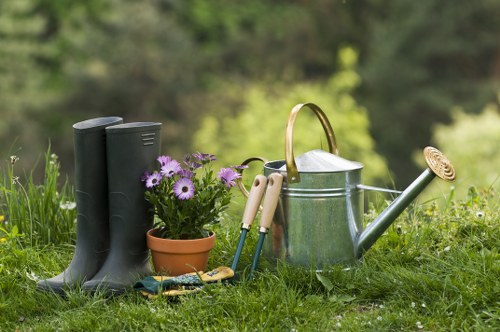Mastering Hedge Trimming in Gardener Gardening
Introduction to Hedge Trimming

Hedge trimming is a fundamental aspect of gardener gardening, ensuring that your hedges remain healthy, aesthetically pleasing, and well-maintained throughout the year. Proper trimming not only enhances the visual appeal of your garden but also promotes the growth and longevity of your hedges.
Understanding the basics of hedge trimming can transform your gardening routine, making it more efficient and rewarding. Whether you're a seasoned gardener or a beginner, mastering hedge trimming techniques is essential for maintaining a beautiful outdoor space.
In this comprehensive guide, we'll explore the various aspects of hedge trimming, including the tools you'll need, the best times to trim, and step-by-step instructions to achieve professional-looking results.
Essential Tools for Hedge Trimming

Having the right tools is crucial for effective hedge trimming in gardener gardening. Investing in quality tools not only makes the job easier but also ensures that your hedges remain healthy after trimming.
Pruning Shears: Ideal for small branches and detailed work, pruning shears provide precision and control.
- Types: Bypass, anvil, and ratchet shears.
- Selection Tips: Choose ergonomically designed shears to reduce hand fatigue.
- Maintenance: Keep blades sharp to ensure clean cuts.
Hedge Trimmers: Perfect for handling larger volumes of trimming, hedge trimmers can be manual or powered.
- Electric vs. Gas-Powered: Electric trimmers are suitable for smaller hedges, while gas-powered models are better for extensive trimming tasks.
- Safety Features: Look for models with safety guards and automatic shut-off features.
When to Trim Your Hedges

Timing is everything when it comes to hedge trimming in gardener gardening. Trimming at the right time promotes healthy growth and maintains the desired shape of your hedges.
Best Seasons for Trimming:
- Spring: Ideal for shaping and encouraging new growth after winter.
- Late Summer: Helps maintain the hedge before the onset of colder weather.
Frequency: Depending on the growth rate, hedges may require trimming several times a year. Fast-growing varieties might need more frequent maintenance compared to slower-growing species.
Step-by-Step Hedge Trimming Guide

Following a systematic approach to hedge trimming ensures consistent results and the health of your plants. Here's a detailed guide to help you achieve professional-quality hedges.
1. Prepare Your Tools: Ensure all tools are clean, sharp, and in good working condition. This minimizes the risk of damaging the hedge.
2. Assess the Shape: Decide on the desired shape of your hedge. Common styles include formal, natural, and espalier.
3. Start Trimming:
- Begin by trimming the sides, working from the base to the top.
- Maintain even cuts to ensure symmetry.
- Step back periodically to assess the shape and make adjustments as needed.
4. Top It Off: Trim the top of the hedge to the desired height, ensuring it aligns with the sides for a uniform appearance.
5. Clean Up: Remove all trimmed branches and debris to prevent pests and diseases.
Tips for Healthy Hedges

Maintaining healthy hedges goes beyond regular trimming. Incorporate these tips into your gardening routine to ensure your hedges thrive.
Proper Watering: Ensure your hedges receive adequate water, especially during dry spells. However, avoid overwatering, which can lead to root rot.
Fertilization: Apply a balanced fertilizer to provide essential nutrients for growth. Follow package instructions to prevent over-fertilization.
Pest Control: Regularly inspect your hedges for signs of pests or diseases. Early detection and treatment can prevent extensive damage.
Common Mistakes to Avoid

Even experienced gardeners can make mistakes when trimming hedges. Being aware of common pitfalls can help you maintain the beauty and health of your hedges.
Overtrimming: Cutting too much at once can stress the plants, leading to weakened growth or dieback. Always trim conservatively and gradually shape your hedges.
- Solution: Limit trimming to no more than one-third of the hedge's total volume at a time.
Ignoring Seasonal Changes: Trimming at the wrong time can impede growth or expose hedges to frost damage.
- Solution: Adhere to seasonal guidelines for trimming to support healthy growth cycles.
Advanced Hedge Trimming Techniques

For those looking to take their hedge trimming in gardener gardening to the next level, advanced techniques can enhance both the functionality and appearance of your hedges.
Shaping and Sculpting: Create intricate shapes and patterns to add a unique touch to your garden.
- Box Hedges: Achieve perfectly straight lines and sharp edges for a formal look.
- Rounded Hedges: Soft, curved shapes contribute to a natural and inviting garden space.
Layered Trimming: Trim different layers of the hedge at varying heights to add depth and dimension.
Topiary: Use hedge trimming to craft elaborate designs and forms, showcasing your creative gardening skills.
Choosing the Right Hedge Plants

Selecting the appropriate plants is crucial for hedge trimming in gardener gardening. Different species offer varying growth rates, foliage types, and maintenance requirements.
Popular Hedge Plants:
- Boxwood: Renowned for its dense, evergreen foliage, ideal for formal hedges.
- Privet: Fast-growing and versatile, suitable for both formal and informal gardens.
- Laurel: Provides a thick, lush appearance with broad leaves.
Consider factors such as climate, soil type, and sunlight exposure when selecting hedge plants to ensure they thrive in your specific garden environment.
Additionally, some plants are more resistant to pests and diseases, reducing the need for extensive maintenance.
Sustainable Hedge Trimming Practices

Embracing sustainable practices in hedge trimming in gardener gardening not only benefits the environment but also promotes the long-term health of your garden.
Composting: Utilize trimmed branches and leaves by composting them, reducing waste and enriching your soil with organic matter.
- Tip: Shred larger branches before adding them to your compost pile to speed up decomposition.
Water Conservation: Implement efficient watering systems, such as drip irrigation, to minimize water usage while keeping your hedges hydrated.
Integrated Pest Management: Use natural pest control methods to protect your hedges without relying on harmful chemicals.
Conclusion

Mastering hedge trimming in gardener gardening is a blend of knowledge, technique, and consistent practice. By investing time in understanding the principles of hedge trimming, selecting the right tools and plants, and adhering to sustainable practices, you can achieve a stunning and healthy garden.
Remember, the key to successful hedge trimming lies in regular maintenance and attention to detail. Whether you're shaping formal hedges or maintaining a natural landscape, these practices will ensure your garden remains a source of pride and enjoyment.
Ready to transform your garden? Contact us today to book professional hedge trimming services and elevate the beauty of your outdoor space.



